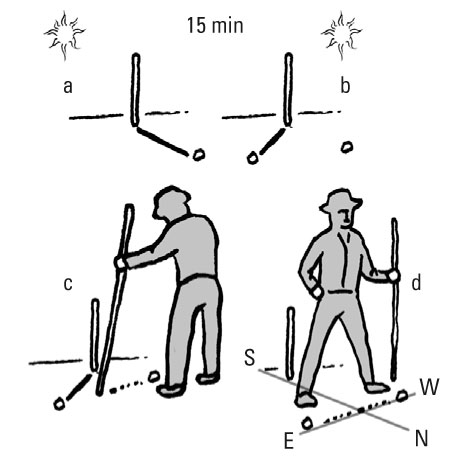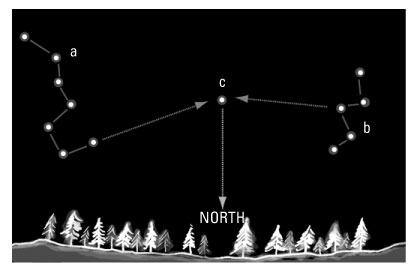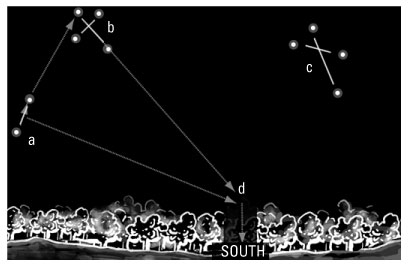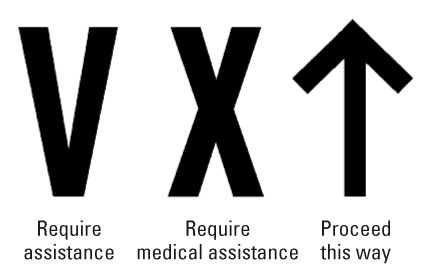If you’re ever caught in a wilderness survival situation, knowing some navigation methods, ways of signaling for help, and how to use various radios and worldwide frequencies will increase your chances of finding your way or being spotted and rescued.
>
>
Improvising Navigation in the Wilderness
Using the sun, the stars, and a little ingenuity can help you find your way in the wilderness and is easy to do more often than not. Remember, people have been using the heavens to navigate for thousands of years. The following techniques can be used anywhere on Earth and are sometimes incredibly accurate, but give you only general direction:
Stick and shadow
Plant a long stick in the ground and mark the tip of its shadow.
Wait 15 minutes and mark new spot. This is the east-west line.
Put your left foot on the first mark and your right on the second. You’re facing due north.

The North Star
The North Star is located between the Big Dipper and Cassiopeia. This method for finding North is always exact. When you’re facing the North Star, west is directly to your left, east, to your right, and south behind you.

The Southern Cross
The Southern Cross lies between the two Pointer Stars and The False Cross. The Southern Cross points perfectly south only when it’s standing straight up. Otherwise, use an imaginary point to estimate due south, as the figure shows:

>
>
>
Methods for Signaling Search-and-Rescue Teams
When you’re in the wild and need help, you send out a signal –- basically anything to get noticed. A good signal not only gets the attention of search-and-rescue teams but also of people not looking for you — passersby who can help before professionals arrive. The following methods show you how to get people’s attention with signals.
Ground-to-air emergency code
These symbols are recognized by Search and Rescue pilots as distress signals. Make sure you make these signals a 6:1 ratio so rescuers can see them from the air.

Aiming reflector
You must carefully aim your mirror’s reflection at the aircraft or vessel you wish to signal, or you may not be seen. You can use a mirror or other reflective items, such as a CD or DVD.

Group splash
If a ring of people all kick simultaneously, the water in the center turns white, briefly, which can be seen against the blue ocean.

>
>
>
Worldwide Distress Frequencies and Phone Numbers
To call for help in an emergency situation, you can use any radio transmitter you have access to, and you can tune it to any frequency to call for help. When in need of rescue, the law gives you unlimited access to radios and their frequencies. However, you’re much more likely to get a faster response if you send a distress signal on a distress frequency. The following is a list of the radios you’re likely to run into and distress frequencies used in different parts of the world:
VHF Radio: Channel 16
CB Radio: Channel 9
Family Radio Service (FRS): UHF: Channel 1
Single-sideband and amateur (ham) radio: 2182 kHz, 14.300 MHz, 14.313 MHz
Air band Radio: 121.5 MHz, 243MHz
UHF Radio (Australia): Channel 5
Cellphones: Try dialing 911 on your cellphone, even if you think you’re not within coverage. Then try texting someone who you know checks his texts. Text is better than voice in many cases because it can get through when voice can’t. If you have plenty of battery power, send a text, and then leave the unit on as you travel. The unit searches for reception until it transmits. The higher you are, the greater the possibility that your cellphone will make contact with a tower.
911: U.S., Canada, Central America (partial), Philippines
066, 060, 080, 911: Mexico.
112: Europe, Australia, New Zealand, Colombia, India, South Korea, South Africa, Israel
999, 120: China (PRC)
110: Jamaica
190, 191: Brazil
1669, 191: Thailand
113, 115: Vietnam, Chile
SOS in Morse code: . . . - - - . . . (3 short tones, 3 long tones, 3shorts)
International distress signal code word: Mayday, spoken three times
>
>
dummies
Source:http://www.dummies.com/how-to/content/wilderness-survival-for-dummies-cheat-sheet.html
No comments:
Post a Comment